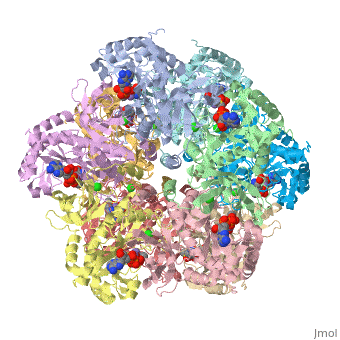User:Tom Gluick/glutamine synthetase
From Proteopedia
Contents |
Introduction
| |||||||||
| 2qc8, resolution 2.60Å (default scene) | |||||||||
|---|---|---|---|---|---|---|---|---|---|
| Ligands: | ADP, CL, MN, P3S | ||||||||
| Gene: | GLUL, GLNS (Homo sapiens) | ||||||||
| Activity: | Glutamate--ammonia ligase, with EC number 6.3.1.2 | ||||||||
| Related: | 2ojw | ||||||||
| |||||||||
| |||||||||
| Resources: | FirstGlance, OCA, RCSB, PDBsum | ||||||||
| Coordinates: | save as pdb, mmCIF, xml | ||||||||
Glutamine synthetase is a key component in the regulation of the concentration of nitrogen containing compounds through out the phyla. The enzyme synthesizes glutamine from glutamate, ATP, and ammonium ion via a two step mechanism involving an glutamyl-P intermediate. The ATP provides the driving force for the reaction by esterifying glutamate's C-3 carboxyl group with the γ-phosphate that is later displaced by ammonia. Glutamine is incorporated into proteins, serves as an energy source, is involved in assimilating ammonia to be used in amino acid and nucleic acid synthesis.
Glutamine synthetase appears to come in three major phylogenetically related classes of structures[1]. The GS-I class is found in many prokaryotes consists of twelve identical subunits arranged as two stacked and interlocking hexameric rings. The crystal structure of the Salmonella typhimurium enzyme has been solved and published in 1989, and its regulation is a subject of textbook discussion[2]. Briefly, the enzyme is regulated precisely via feedback inhibition by metabolic products such as glycine, alanine, carbamoyl phosphate, CTP and five others, and covalent modification via the adenylylation of tyrosyl residue. Crystal structures for Salmonella typhimurium glutamine synthetase illustrate adenylylated, unadenylylated, and ligand bound states (1lgr[3], 2gls[4], 2lgo[5], 1f1h[6], 1fs2[7] and 1fpy[8]). Explaining how this enzyme works is the focus of your projects.
The human enzyme is classed as GS-II. The quaternary structure consists of ten identical subunits arranged as two pentameric rings stacked atop each other [9] as shown in the Java Applet on the right hand side of the page. It is activated by Mn and several other divalent metal cations and α-keotglutarate; the enzyme is inhibited by methionine sulfoxime, glycine and carbamoyl phosphate.[1]
Glutamine synthetase is a key component in controlling ammonia concentrations, maintaining nitrogen balance among organs, acid-base homeostasis, gene regulation and signaling.[2] Glutamine homeostasis is maintained in part via regulating transcription and GS protein degradation. [3].
In ureoteles, glutamine serves as a nontoxic shuttle of excess ammonia as its transported from tissues not capable of processing ammonia further through the blood to the liver where amide nitrogen eventually ends up in urea. For neurons in the brain to function normally, the excititory glutamate generated by the neuron is absorbed by the astrocyte and recycled to glutamine by GS.[4]
Disruptions in glutamine homeostasis brought about through cancer, trauma or HiV infection can lead to organ failure and death. Although extremely rare and only seen in the children of consnaguionoius couples, that defects in GLUL ( the gene encoding for gluatmine synthetase) causes a congenital disorder leading to brain malformation and death in neonates[10].[5]
Below the cartoon shown in the JMOL applet is a wealth of information linked to this site. Links immediately below provide views of ligands associated with the protein. Click on ADP or any other ligand in the green region will show cause the protein to become transparent revealing the buried ligand. Clicking on green link initial scene will return the image to the original scene. More information about the structure is found in the human glutamine synthetase stub[11] and references sited therein. This information can be also accessed by clicking the PFAM links in structural annotation resources. Clicking on the domains reveals the CCD database complied by NCBI. Images of the two GS domains can be visualized using this link. PDBsum and the RCSB links provide complementary information on ligand-protein interactions, protein-protein contacts, and literature citations as well as providing links to other resources.
Before you start the project, I suggest you view the video tutorial in [12] to provide you with the tools to get started and give you a great overview of the power of proteopedia. I also suggest that you be aware of scene authoring tools with detailed explanations link given in[13] and the editing page access in Help.
References
- ↑ Haussinger, D., & Schleiss, F., Glutamine metabolism and signaling in the liver, Forntiers in Bioscience 2007, 12, 371-391.
- ↑ Curi, R., Glutamine, gene expression, and cell function. Frontiers in Bioscience 2007 12: 344-357.
- ↑ Labow, B. I., et.al., Mechanisms Governing the Expression of the Enzymes of Glutamine Metabolism—Glutaminase and Glutamine Synthetase. J. Nutr. 2001 131: 2467S–2474S.
- ↑ Albrecht, J., Glutamine in the central nervous system: function and dysfunction. Frontiers in Bioscience 2007 12:332-343.
- ↑ Haberle, J., et.al., Congenital Glutamine Deficiency with Glutamine Synthetase Mutations. New Engl J Med 2003 353:1926-33.
Preface to the Project: First Things First
The following is a series of instructions designed to help students to complete an assignment in Biol 430 (Biological Chemistry) at the University of Maryland, Baltimore County. The instructions are divided into three sections.
In Section I, images are constructed using the Scene Authoring Tools. In the Section II, images are constructed using the JMOL command language. Section I consists of four exercises. In exercise 1 the commands are in bold type followed by simple explanations. The link will reveal an image resulting from the commands. In exercise 2, the commands are listed with less explanation; the image is shown both as a still image and is accessible as a link. In exercise 3, the commands to construct the image shown as a still image are given. In exercise 4, you go solo. Your job is to use the commands to construct the images in your protected pages or in the sandbox. The only image that needs to be permanent is the one generated from the Going Solo Exercise. When credit is given for the exercise, you may remove it from ypur page.
Section II is a section intended for the advance user and is not a required section to complete unless you want to write your own commands. These commands show you how to do a few things that you cannot do with the scene authoring tools.
Section III contains information of the glutamine synthetase project. An outline of the project is given followed by individual assignments on a structural and/or functional aspect of glutamine synthetase. A single assignment will be assigned to a group. The due date is noted in the syllabus.
Section 1: Using Scene Authoring Tools
I have found that the tools are great for making instructive images with reasonable ease and a short learning curve. I feel that for most images, the SAT are sufficient. However, writing JMOL script using the Console accessed through the JMOL frank ( the frank is in the lower right hand corner of the applet.) allows for more versatility with the price of a longer learning curve along with the frustration of writing scripts correctly.
Exercise 1: USING SCENE AUTHORING TOOLS WITH EXPLANATIONS
Below are the sequence of commands I used to construct a scene that is accessible in the green link below the script. The image portrays the enzyme in differently than before. Here, the protein is reduced to a tracing of the protein backbone which reveals the ligands, ADP, P3S, Cl- and Mn2+ as spacefill models within the protein.
|
1. Open Scene authoring tools ( scroll down-this allows you to load an image from the PDB or a previously saved scene).
2. Click on the Load Molecule Tab (one of the options. This one allows you to load the PDB file).
3. Type in 2qc8(the combination of four letters or numbers signifies the file containing the coordinates to describe a crystal structure of human glutamine synthetase.).
4. Click on Selections Tab (this tab will bring up a new window that will let you select all, none or parts of the structure).
5. Click on Select None ( this sets it up so you want to add to a selection) Select all, you use this to remove stuff from selection.
6. Highlight the selection in the large box called: all protein, then click on Add to Selection.(this will add the protein, and hopefully nothing else to be subject to the next set of operations).
7. Click representations tab ( you can fool around here to discover the many different ways of representing a molecule) I chose Backbone and clicked on the set representation button. The ligands will be plainly visible as spacefilling models.
8. Click on colors Tab.
9. Again we are faced with many choices and you are welcome to fool around. I chose to Color by Chain. This color each chain a different color and ligands associated with the chain, the chain color. One could choose Rainbow. This colors the N-terminus blue and the C-terminus red, the opposite of ROY G BIV.
10. What we have done is created a script of commands to yield the representation of the molecule seen in the JMOL window. To save the script, we click on the save scene tab. Name and describe the script in the appropriate boxes.
11. Now copy the Wiki script, paste it in document, put a title in the script, and insert in the document. The wiki script has this format: <scene name='User:Tom_Gluick/glutamine_synthetase/Backbone_trace/1'>Insert text here</scene> I inserted the text: Example: Backbone Trace with ligand.
12. Hide the tools and hit preview to test it out.
When scene is to your liking, scroll down and click on Save Page; if not, then hit the back button of your browser and edit.
The wiki script called Example: Backbone Trace with ligands was inserted within this sentence.
Exercise 2: LIGAND AND CHAIN SELECTION WITH LABELING
Now the following set of commands will provide an image that highlights the ligands and ions found in the crystal structure in a nearly transparent protein. In this assignment,your goal is to generate the image you shown below as still image.
1. Return to scene authoring tools.
2. Load scene-TAB and choose the Back_trace, version 1( of course you can load the molecule again using the PDB code).
3. Selections/select none/halos this means hit selection tab, select n button, and check halos.
4. Groups/ligand/limit to chains: type in A/add to selection/center/invert selection. This set of commands selects for ligands in chain A, centers on ligands, and inverts the selection.
5. Represent/hide selection/-halo/ zoom Hit represent tab and hide selection and remove halo for clarity, zoom by holding shift down and using mouse.
6. Color/CPKThe ligands ought to be colored by CPK convention. Now hover over the green ball by placing mouse cursor on top of it; you now ought to see Cl703, Chain=A, Element=Cl; the 703 corresponds to Cl residue number.
7. Select/none/A/Cl/add/halo Only the green ball ought to have a halo surrounding it.
8. Label/element/color label black/label size 16/on/set label This will label the green ball with Cl in black at 16 Font size with a pointer on the ball; the font size does not change with zoom.
9. Hover to find Mn. Select one or all the Mn (purplish color) with mouse click using .../set label/ These commands will label Mn using previous settings.
10. Hover to find ADP. Select a single atom with mouse clicl/pick three letter code/set label/These commands will label ADP.
11. Hover to find P3S. Repeat.
12. Selection/all protein/A/add to selection.
13. Representation/trace/set representaton/-halo.
14. Color/pick a color that contrasts well with label color/transparency 50%
14. Save scene with spin on/copy wiki text/paste it in/name it/ preview it/save it.
|
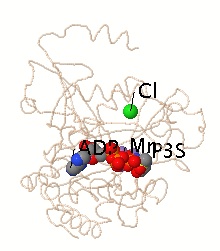
The ADP, P3S, the chloride in green, and Mn in purple are labeled.
We are now able to show:Labeled Ligands in Chain A.
Exercise 3: ACTIVE SITE RESIDUES
Select amino acid residues, ions and ligands found in the active site of human glutamine synthetase. The information is found in PDBsum website which is accessed by a link in the opening applet. PDBsum is a database of summaries of macromolecular structures deposited in the PDB. Each deposited structure has its own web page containing a compendium of images depicting various aspects of macromolecular structure. You will use the site to uncover the amino acid residues making contacts with the ligands by hydrogen bonds or electrostatic bonds; these can be found under the ligands tab. The contacts can be downloaded as a PDF file. The contacts of interest are those represented by amino acid structures-I suggest you write these down. The following are a sketch of commands used to come up with the still image.
1. Load 2qc8
2. Click select none under selection tabs. Limit the amino acid residues and ligands to chain A. Type in the amino acid residues that make hydrogen or electrostatic contacts with the ligands; do not include Mn at the moment. Obtain this information from the PSBsum webpage.
3. Invert the selection, hide the inverted selection, and invert again.
4. Center and zoom.
5. Convert the selection structure from cartoon to wireframe.
6. Set the colors to CPK.
7. Now select the three Mn in Chain A, use the halos to make sure you only select Mn. You might want to select none first.
8. Set the spacefill at 50% and set representation.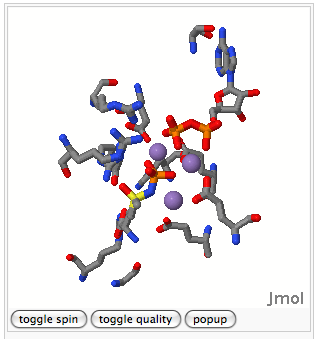
insert wiki here Active Site Amino Acid Residues with ligands
Exercise 4: GOING SOLO
Construct the image shown below based on the following description. A salt bridge between Chain F Residue 63 and Chain G Residue 319. Residue 63 and 319 wireframe, the rest of the molecule is trace and somewhat transparent.
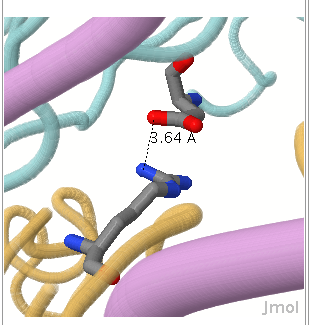
Section 2. Using JMOL Commands in the Console
If you scroll up to the original JMOL applet, and click on ADP, you will notice that the image fades allowing the ligand to become prominent as it zooms in and out while the image spins. To zoom you just need to hold down shift and then drag the molecule up and down to Zoom in the Scene Authoring Tools.
|
In the following paragraphs I will illustrate how to use several commands in JMOL which avoid some steps in the SAT. The commands i will illustrate are zoomto, select, restrict, color, translucent and... . make the scene using JMOL command language in the JMOL console. The Console is accessed through the JMOL at the bottom of the figure in the JMOL Console Practice Applet. Click on JMOL to access the pulldown menu and drag cursor to Console. The console is a place where explicit commands using the JMOL language can be used. The language takes some time to learn but it offers a lot of control. The scene authorOpening tools that proteopedia uses are useful for less complicated edits or when the PDB file is annotated very well with many details, like the one shown in the example movies.
Open Screen authoring tools<br/>
load molecule/by PDB code 2qc8/click load--this will post load /cgi-bin/getpdbz?2qc8 with script /wiki/scripts/initialview02.spt
AND spin off IF YOU PRESS THE HISTORY TAB IN THE CONSOLE.
click on JMOL frank to reveal a pulldown menu; choose console the console opens
select protein--using this command selects only those atoms called protein
color gray--this will color the selected residues gray; any color after color can be used.
color translucent 200--this command will make the selected residues translucent--the higher the number the more translucency
restrict protein, ADP--this is the restrict command that restricts the display--the statement says to restrict protein and ADP (note comma) meaning only protein and ADP are diaplayed
zoomto 3 150--this command can be used to zoom in or out. the first number says zoom occurs in 3 sec and the second the percentage increase or decrease, in this case 150%
set echo bottom center; font echo 20 bold; color echo black--this sets the label format to bottom center, font details and color
echo "Adenosine Diphosphate"--this is the label
Click save screen in SAT and select Spin ON
The WIKI appears and copy it and place it in the text.
Now, you ought to give this a whirl. If you are up to it, construct a script that would zoom and spin; translucency 200, color protein orange, color P3S black restrict to P3S and protein. Your target as a still figure ought to look similar to the figure shown here.
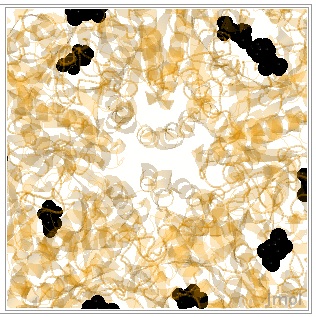
|
The commands to label the active site are listed below; these commands illustrate various ways to label amino acid residues or ligands. The script also uses the restrict and select commands, turns off spacefill and cartoon and introduces wireframe. You are also given the command to center rotation upon a single residue. You are introduced to new coloring schemes and introduced to new code to describe individual atoms of amino acids.
load /cgi-bin/getpdbz?2qc8
script /wiki/scripts/initialview02.spt
spin off
loadedfileprev = "2QC8" This command loads the molecule in SAT.
zoomto 2 800 Expands the molecule in 2 seconds 800 per cent.
select all
wireframe 0.3 Sets the width of the wire frame model
cartoon off Turns the cartoon off leaving the wireframe behind. </br>
spacefill off Turns off the spacefill function now the ligands are wireframe.
restrict 324A, 338A, 134A, 501A, 203A, 257A, 601A Restricts display to these residues only.
center 203A Centers the display on amino acid 203A
color amino Colors selected amino acid with color corresponding color.
select 501A
color cpk Colors selected amino acid with CPK colors.
select 601A
color CPK
select 401A, 402A, 403A
spacefill
spacefill 50% Decreases the size of the spacefilled molecule or atom to 50% of default size.
label SER Labels all the residues of 257A SER.
select 324A.CA Select 324 amino acid residue C alpha atom.
label ARG; color black label the above ARG and color it black.
select 338A.CA; color label black; font label 20 bold; label GLU the font label is set to 20 and is bold
select 203A.CA; color label black; font label 20 bold; label GLU
select 203A
color CPK
select 501A.O
set picking on
select 501A.N7
label ADP
select 401A, 402A, 403A
label Mn
select 601A.SD; color label black; font label 20 bold; label P3S
select GLU134A.CA; ; color label black; font label 20 bold; label GLU
spin on
Section 3. THE GLUTAMINE SYNTHETASE PROJECT
As a class project the group will begin to describe the relationship of the structure of prokaryotic gluatamine synthetase to its function. Each group will complete a small segment of the project which will be eventually linked to a main page on Glutamine synthetase. I picked Glutamine synthetase because for a long time I have been fascinated with how it works, how it is put together, its pivotal role in nitrogen metabolism, and its beautiful symmetry. By studying the structure of GS in detail, the student ought to ....
- 1. learn how to use a structure viewer
- 2. learn how to the compose a WIKI.
- 3. exploit information from databases
- 4. convert literature descriptions into a vibrant learning module
- 5. improve comprehension of protein structure
- 6. improve comprehension of ligand binding and enzyme activity
- 1. learn how to use a structure viewer
In the next section, I present the project outline. We will probably not cover all the topics presented in the outline. In the introduction, the topics will be introduced with a link to the page. In the project section, the student projects are listed.
Outline of the Project
I. Introduction to glutamine synthetase
II. GS structure--Overall View
- A. Quaternary Structure
- B. Tertiary Structure
- C. Secondary Structure
- D. Primary Structure
- A. Quaternary Structure
III. Subunit Interactions in Quaternary Structure
- A. β-loop
- B. Central loop
- C. Helical Thong
- A. β-loop
IV. Ligands and Substrates
- A. ATP
- B. Glutamate
- C. Ammonium
- D. Metal Ion Binding Sites.
- D. Inhibitors
- A. ATP
V. Active Site and Enzymology
- A. Substrate Analogs
- A. Substrate Analogs
VI. Covalent Modification
- A. Adenylylation
- B. ADP Ribosylylation.
- A. Adenylylation
VII. Conclusion
Assignments [1]
Assignment 1: IIA. Quaternary Structure: Provide an overview of the quaternary structure of Salmonella typhimurium Glutamine Synthetase. Your explanation ought to include stoichiometry, how the monomers are joined to from the quaternary structure, a clever way to show the symmetry, an indication of the active site location.[2]
Assignment 2: IIB. Tertiary Structure: Map the two Pfam domains in the GS; Include in your discussion what Pfam database records[3]; Define the role of each domain in the protiein. You can use the viewers provided in the Pfam site, but I had some difficulties with all three; JMOL did not load the molecule properly; Astex, never did load the molecule, and SPICE did, but the viewer is complicated to operate. Your experience may be different. Show the general design of the active site; reference 1 contains useful material[2].
Assignment 3: IIB. Tertiary Structure: Map the two CATH domains in the GS; Include in your discussion what CATH database records[4]; explain the significance of each domain. In your discussion show the features of the CATH architecture and topology that provides them with the designation. As a hint you may want to use the Jena Library Jmol[14], which can be access through PDBsum[15] to assist you in mapping the CATH domains. The RSCB site may not list the domains correctly.[16] [2]
Assignment 4: IIB: Tertiary Structure: Map polar/nonpolar or charged and uncharged regions of GS monomers. Use space filling model. Map where polar and nonpolar residues are located in the protein. Comment on significance.[5]
Assignment 5: IIC: Secondary Structure: Dissect a monomer into secondary structure elements. You may want to include a wiring diagram or use the wiring diagram in PDBsum[17] as an aid in presenting. Briefly comment on the significance of the elements when required.[5]
Assignment 6: IID: Primary Structure: Map the conserved residues on an individual subunit. Comment on the significance of the conservation using applets or images to enhance discussion of the topic. See discussion of Wiki Colors in Help: Editing to be used to enhanced your presentation. [2]
Assignment 7: IIIA: β-loop: Map the interactions stabilizing quaternary structure. Explain how these interactions contribute to quaternary structure stability. [2][5]
Assignment 8: IIIB: Central-loop: Map the interactions involving the central loop that stabilize quaternary structure. Explain how these interactions contribute to quaternary structure stability.[2][5]
Assignment 9: IIIC: Helical thong: Map the interactions involving the helical thong that stabilize quaternary structure. Explain how these interactions contribute to quaternary structure stability.[2][5]
Assignment 10: IVA: ATP Binding site: Map the ATP binding site; indicate which residues stabilize ATP binding; indicate which residues are important for activity and how they contribute to catalysis. [2][5][6]
Assignment 11: IVB: Glu binding site: Map out the Glu binding site and explain how Glu binds, you will need to consider the inhibitor phosphothricin as a good analog of glutamate.[7] Indicate which amino acid residues are important in stabilizing Glu in the binding site. Indicate which residues are involved in chemistry.[2][8]
Assignment 12: IVC: Ammonium Binding Site: Map the Ammonium binding site and explain how it contributes to cataysis.[9]
Assignment 13: IVD: Inhibitors: Explain how a competitor inhibitor binds to the active site. [2][10]
Assignment 14: VA: Transition State Analogs: Map the transition state in Mycobacterium tuberculosis crystal structure. Show the important interactions involved in chemical steps directly.[8]
Assignment 15: VIA: Map the Adenylylation site on the tertiary and quaternary structure of GS with an explanation of how it happens and how the covalent modification affects enzyme activity.[2]
Assignment 15: VIB: Map the ADP-ribosylation site on the tertiary and quaternary structure of GS with an explanation of how it happens and how the covalent modification affects enzyme activity.[2]
Instructor Project: I and II: The introduction and the conclusion.
Examples of Student Projects
A few comments on the assignment are below each presentation.
To see an example of Assignment 3: IIB. Tertiary Structure:/Assignment 3
To see an example of Assignment 8: IIIB. Central Loop:/Assignment 8
To see an example of Assignment 1: IIA. Quaternary Structure:/Assignment 1
Overall Assessment and Advice to Others Wishing to Design Assignments in Proteopedia
I taught a one-semester biochemistry course, where I focused upon structures, enzymes, kinetics. regulation and pathways. Topics related to the central dogma were not discussed.
Procedure: Students chose three topics from the list above and were assigned one of their choices for which they received one point. Students then registered at Proteopedia and completed the assignment teaching them to become comfortable with SAT. Completing the assignment earned the students 5 points. Students then submitted a rough draft. Students were evaluated on rough drafts and were required to meet with the instructor for mid course adjustments. The rough draft included all test and included place holders for WIKI scripts. Students could earn a maximum of nine points for the rough draft. Students submitted the final draft. If I felt more work was required, I gave the students more time to complete the task. Between the time of the rough and final draft students were allowed to ask to have their sites evaluated without being graded. Students could earn 10 points for the final draft. Total points: 25 points.
Grading was lenient since students were beta-testers.
What I learned: The SAT is simple enough for students to master, a testament to those who designed the tools. Most students were able to muster a reasonable project; at least one project was top notch; several were very good and one was a failure. Students can produce very elegant scripts, but most will not have the patience nor imagination to do so.
References
- ↑ PDB codes for the assignment are listed in the introduction. For instance, PDB code for 1lgr may be useful in assignment 10.
- ↑ 2.00 2.01 2.02 2.03 2.04 2.05 2.06 2.07 2.08 2.09 2.10 2.11 Eisenberg, D., et.al., Structure-function relationships of glutamine synthetases, Biochim Biophys Acta 2000: 1477, 122-145.
- ↑ Bateman, et.al.,The Pfam Protein Families Database, Nucl Acids Res, 2000: 28, D263-D266;Bateman, et.al.,The Pfam Protein Families Database, Nucl Acids Res, 2004: 32, D138-D141
- ↑ Pearl, F., et.al.The CATH Domain Structure Database and related resources Gene3D and DHS provide comprehensive domain family information for genome analysis, Nucl. Acids Res. 2005 22: D247-D252
- ↑ 5.0 5.1 5.2 5.3 5.4 5.5 Yamashita, M. M., et.al., Refined Atolnic Model of Glutamine Synthetase at 3.5 A Resolution, J Biol Chem 1989 264: 17681-17690.
- ↑ Liaw, S-H., Interactions of Nucleotides with Fully Unadenylylated Glutamine Synthetase from Salmonella typhimurium, Biochemistry 1994, 33: 11184-11188
- ↑ Gill, H & Eisenberg, D., Biochemistry 2001 40: 1903-1912
- ↑ 8.0 8.1 Krajewski, W. W., et.al.,Structure of Mycobacterium tuberculosis glutamine synthetase in complex with a transition-state mimic provides functional insights, Proc Natl Acad Sci 2005, 102; 10499-10504.
- ↑ Liaw, S-H, et.al.,Discovery of the ammonium substrate site on glutamine synthetase, a third cation binding site Protein Sci. 1995 4: 2358-2365
- ↑ Liaw, S-H., et.al.,Feedback inhibition of fully unadenylylated glutamine synthetase from Salmonella typhimurium by glycine, alanine, and serine, Proc Natl Acad Sci 1993 90: 4996-5000.
